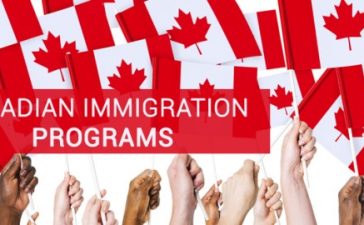Transitioning from Temporary to Permanent Residency in Canada is now simpler. A motion was passed in Canada calling on the government to create a plan to increase the variety of economic immigration routes available to prospective immigrants and to facilitate the easy conversion of temporary resident status to permanent resident status for workers of varying levels of experience and education.
A Proposed New Act in Canada, Bill M-44
The Private Member’s Motion M-44 was introduced by the Liberal Member of Parliament for Surrey Centre Randeep Sarai. Within 120 days of the motion’s acceptance, the government was obligated to develop and release a detailed strategy to increase the economic immigration stream’s capacity to absorb employees with varying levels of education and experience.
The goal is to ensure that all labor demands are met and to provide legal avenues for temporary foreign employees to become permanent residents. Included in this group are overseas students who have substantial work experience in Canada, particularly in industries where there is a persistent shortage of competent workers and a deficiency of abilities.
This is what the official government motion read:
“…such a strategy should include the following components: (a) revising eligibility criteria under economic immigration programs to provide greater weight to relevance in Canadian work experience and broaden the acceptable occupational categories and work experience at various skill levels.”
Since temporary foreign employees and international students are so important to Canada’s economy, the government wants to make it easier for them to become permanent residents. In addition to aiding in the economic recovery and advancement of the nation, the diverse skill sets and educational backgrounds of foreign employees also contribute to the growth, innovation, and productivity of businesses. They also assist in satisfying the immediate manpower needs of several businesses. Canadian universities benefit greatly from the presence of overseas students since they boost productivity, add to the size of the labor force, and help offset the consequences of an aging population.
Private Member’s Motion M-44 generally backs the objectives of Immigration, Refugees, and Citizenship Canada (IRCC), which is to ensure that newcomers to Canada are welcomed and integrated in a way that maximizes their contribution to the nation while protecting Canadians’ health, safety, and security.
There is already an integral part of the Canadian immigration system in place that facilitates the change from temporary to permanent status. Existing programs provide a path to permanent residency for temporary foreign employees and international student graduates in a variety of industries and skill levels.
Candidates with the greatest potential for long-term economic success in Canada are those who can quickly and easily integrate into the country’s workforce. People with these skills are better able to weather economic downturns and job market shifts in the future.
It is the goal of this strategy to enhance the likelihood of temporary residents becoming permanent residents in order to better meet the labor demands, shortages, and local and regional needs in Canada.
The link between the Canadian labor market and Canada’s immigration policies should be fostered to ensure that the Canadian economy has access to the vast range of skills needed across all industries. The Canadian government says that
Expanding or modifying the current paths for foreign nationals who wish to live and work in Canada, especially international student graduates, is a top priority for us.
To find a happy medium between the immediate demands of Canada’s business community and the medium- and long-term goals of the economy, it will be required to deploy the proper immigration mechanisms. Both the safety of people in precarious positions and the advancement of domestic workers are priorities for the administration.
The Canadian government has announced plans to increase the number of people eligible to apply for permanent residency (PR) by implementing a variety of new policies. Included in this growth are the several pilot projects and initiatives that help international students and temporary foreign employees get citizenship.
Component 1
This Levels Plan is an effort by the federal, provincial, and territorial governments to find a middle ground between the speed of growth and the time and resources needed to prepare for and welcome new immigrants. This includes ensuring that localities can meet rising needs for infrastructure including housing, healthcare, education, transportation, and settlement services and that national and local governments can efficiently handle a growing number of applications of varied complexities.
Component 2
The second pillar’s goal is to make Express Entry more up-to-date in accordance with the Immigration and Refugee Protection Act by, for example, expanding the discretionary powers of the system’s immigration-selection tools. The Minister will be able to meet the demands of the labor market, advance regional economic goals, and accommodate an increase in the number of Francophone immigrants if he or she prioritizes applicants who possess particular qualifications, such as experience working in Canada.
The Department will also review the criteria of the Express Entry Comprehensive Ranking System, paying special attention to the weights granted to a candidate’s employment and educational history in Canada, their language skills, and a job offer. After talking to key stakeholders, the Minister will be in a better position to ensure that the labor market meets the needs of businesses and industries across Canada. These changes serve as the foundation for the next major release.
Component 3
The third pillar entails adopting the National Occupational Classification (NOC) 2021, the most recent revision of which expands eligibility for a variety of permanent economic immigration options for a number of in-demand professions, to aid in the transition of vital employees in high-demand occupations from TR to PR. The goal is to provide more resources to newcomers, check their credentials, and help them get connected to relevant federal, provincial, and territory initiatives.
Finally, the government plans to make adjustments to pilot programs that help those working in the agri-food business and in-home caregiving make the transition to permanent residency, as well as explore better ways to transfer in-demand key professionals like physicians.
Component 4
Assisting communities, especially those with a need for French speakers, in attracting and retaining immigrants is the focus of Pillar 4. As part of its efforts to increase the number of French speakers in Canada to 4.4% by 2023, the government is actively supporting Francophone minority communities outside of Quebec. Further, a Municipal Nominee Program is being established to facilitate local governments’ efforts to recruit and retain immigrants to address labor shortages.
Through initiatives like the Provincial Nominee Program, the federal government is empowering provinces, territories, and enterprises to adapt and improve their immigration channels to meet the needs of their local labor markets.
Component 5
The government is increasing its processing capacity, improving the customer experience, and bringing the immigration system into the current day by utilizing technological advances. These initiatives work toward the goal of expeditiously gaining permanent residency for foreign nationals in Canada.
Canada welcomes more and more immigrants each year, but there are risks associated with this trend that must be mitigated, including wage repression, the displacement of local workers, and a reduction in incentives for investment in capital and technology.
The larger economic climate of rising inflation and interest rates must be considered as well by the immigration system, since this may reduce consumer demand and economic activity, and may also have a detrimental impact on the standard of living and affordability for Canadians, including immigrants.
Publication of Immigration Data
The data and tendencies about temporary workers revealed the following:
Since 2015’s updates, the number of persons holding work permits under the Temporary Foreign Worker Program (TFWP) and the International Mobility Program (IMP) has increased (IMP).
There has been a rise in the number of people with both employer-specific and open work permits, although the number of people with open work permits has climbed by around 110 percent between 2015 and 2021.
The nearly 290% growth in post-graduation work permits between 2015 and 2021 indicates that a large percentage of this demand is connected to Canada’s international student program (from 33,575 to 130,695).
Around 31% of all work visa holders in 2021 were college graduates.
Numerous permanent economic immigration plans are currently available to temporary foreign workers. There has been a dramatic increase in the use of various methods of transition since the early 2000s. In 2021, over 168,600 individuals, or 64 percent of all economic admissions, changed their status from temporary workers to permanent residents.
The Canadian Federal High-Skilled Programs (Canadian Experience Class, Federal Skilled Worker Program, and Federal Skilled Trades Program) have historically been the largest economic immigration category in Canada, as defined by the Immigration Levels Plan, which establishes targets and ranges for overall admissions for immigration categories.
In 2021, 139,460 permanent residents (or about 34%) were admitted through these channels. Several foreign students and temporary workers choose to immigrate to Canada through one of the many provincial nominee programs.
The rate of transition from temporary to permanent employment has increased dramatically during the previous two decades. In the three years leading up to the outbreak, the rate of transformation accelerated by 27%. In 2019, there were 63 thousand persons who went from being temporary workers to permanent residents.
Though entering the nation lawfully for the purpose of finding work is the major reason for immigration, people entering for family reunification or as refugees also make significant contributions to the economy, satisfy market demands, and join the labor force.
Potential immigrants may look forward to policies being enacted that support their aspirations, regardless of skill level. The government places a premium on keeping foreign employees who have established roots in Canada. Individuals seeking to reside in Canada on a temporary basis can look forward to having the opportunity to remain longer.


